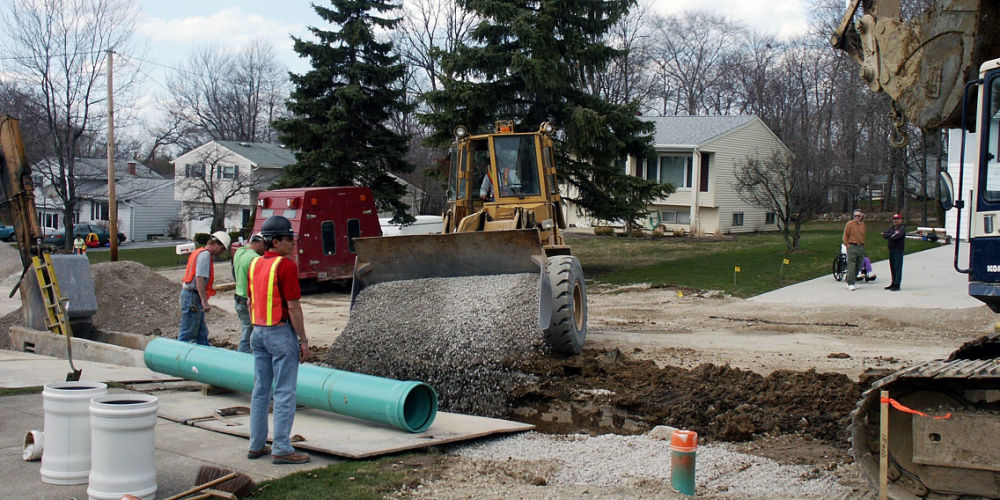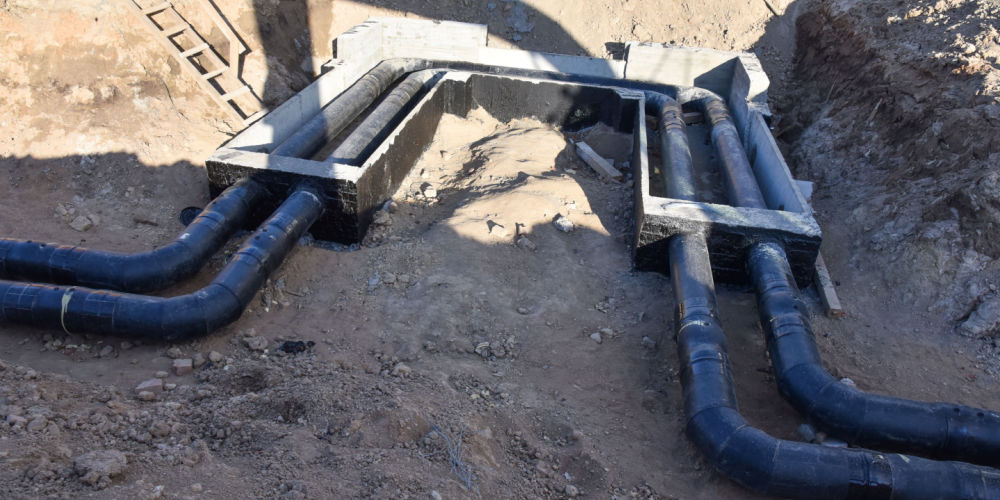
When your sewer line fails, you may face a big problem – and an even bigger bill. Sewer line replacements can be expensive, and few of us have extra cash for this type of emergency.
Whether you need to replace all or part of your sewer line, understanding the cost breakdown will help you make a well-informed decision about how to proceed. In this article, we’ll look at the factors influencing sewer line replacement costs and provide tips for keeping costs down.
We’ll also answer questions like “How much does a sewer line replacement cost?” and “Are there ways to reduce the cost of replacing my sewer line?” So buckle up – let’s get started!
The Cost of Sewer Line Replacement
Replacing a sewer line is never a fun experience, and unfortunately, it doesn’t come cheap. The cost of replacing your sewer line depends on where you live, the depth of your line, and the materials used. Generally, most USA homeowners expect to pay between $2,000 and $15,000 for a complete sewer line replacement.
The two main component costs are:
- Hourly labor charge – US plumbing/excavation companies typically charge by the hour for their services at around $50 to $150 per hour. This charge covers inspections, exploratory digging, repair & replacement of the existing pipe, installing a new tube, and repairing any damage caused during the sewer line replacement project.
- Materials – This cost covers all necessary parts and materials, such as pipes (from ABS plastic to high-end stainless steel), seals & fittings. These vary in price depending on location but are usually approximately $10-$20/foot plus whatever additional parts may be needed for the job (e.g., cleanout pipes).
Researching local plumbing companies can help you understand what’s involved with these jobs—and how much it will cost you—before you embark on this journey!
Warning Signs of a Damaged Sewer Line
If your home has a sewer line that’s damaged or failing, you’re at risk for significant headaches and costs—primarily if you don’t address the issue quickly. The good news is you can look for signs that your sewer isn’t functioning correctly.
Some of the usual warning signs of a faulty or damaged sewer line include the following:
- Unpleasant odors are coming from your drains—smell bad, like sewage.
- Multiple clogged drains at one time can indicate a blockage in your sewer line.
- Gurgling sounds—oh no, it almost sounds like something’s alive there! These gurgling noises indicate that air bubbles are rising through the water in your pipes, which means there’s not enough force to push the wastewater down and out of your home.
- Toilet backflow—yuck! If wastewater enters your toilet instead of flushing out as it should, there’s something up with your sewer line.
If you notice any of these signs, don’t hesitate to call in a professional to inspect and assess the problem as soon as possible. Knowing what to watch for can save you time and money.
Indicators That a Sewer Line May Need Replacing
If you’ve been living in your home for a while and feel uneasy about the state of your sewer line, a few signs could indicate it may need to be replaced. Even with regular maintenance, age and wear and tear can take their toll, so make sure to pay attention to the following:
Low water pressure
If you experience low water pressure in faucets throughout your home, that could be a sign of a clogged sewer main line. It’s possible that material is flowing back into the house—a definite sign of distress.
Blocked drains
If multiple drains in your home are prone to clogs at the same time, then it’s likely that all these blockages are backing up from one major clog in the main sewer line.
Foul odors outside
Do you notice any strange smells near exterior walls or outdoor drains? If so, these smells may come from sewage backups or cracks in your sewer lines. Perform a check on them as soon as possible!
Unpleasant noises
Sewer lines contain air pockets, creating noises when bubbles break, such as gurgling. These noises can be heard anywhere from sinks, toilets, and showers—which means that materials from one side of the line are making their way to another.
If any signs ring true for you and your home, it may be time for professional help. Having a plumber inspect your sewer line is critical; they will determine whether it needs replacing or if there’s a more straightforward solution!
Factors That Impact Cost of Replacement
Some factors come into play regarding how much a sewer line replacement costs. Here’s what you need to know:
Excavation requirements
It’s important to factor in all the excavation work necessary for the project—including removing earth, trees, and landscaping—and any additional digging work needed. In short, excavation makes up the bulk of the cost for this type of project.
Materials used
The type and amount of materials used for your sewer line replacement can also change cost estimates—which is why it’s essential to get a breakdown of what these materials will be from your contractor. In most cases, you’ll need cement, clay pipes, PVC pipes, polyethylene pipes, and other materials designed explicitly with durability.
Labor costs
As with any building project, labor costs can be considerable. Plumbers must be experienced in working with complex sewer systems and aware of local codes and regulations when installing new lines. When you get a quote for your project, ensure it includes the cost of hiring experienced labor–it could save you money in the long run!
DIY vs. Professional Sewer Line Replacements
It’s no secret that sewer line replacement costs can be high, but you may wonder if paying a professional is worth it – or if you should DIY.
When it comes to replacing a sewer line, there are a few things to consider:
DIY Costs
Do-It-Yourself homeowners may be tempted by the idea of saving extra money by taking on the job of replacing their sewer line. However, these projects require specific knowledge and time investments as they are labor-intensive and typically involve digging a trench which can lead to additional – sometimes even more expensive – repairs. Additionally, without the expertise or experience of a professional, you may have difficulty obtaining the necessary permits and city regulations.
Professional Costs
Hiring a professional will provide access to experts and technicians who can inspect your existing sewer line, determine what needs replacing and help facilitate and complete any permitting requirements. Professionals also have access to specialized tools and equipment to help minimize your costs for materials such as pipe liner bypass systems. And since warranties back all work, any repairs done if an issue arises during installation can quickly be taken care of without additional cost to homeowners.
Financial Resources to Help With Sewer Line Replacement Costs

Your sewer line replacement cost can be overwhelming, but you mustn’t bear it alone. A few financial resources can help you offset the cost of replacing a sewer line.
Government Loans & Grants
Homeowners who qualify may be eligible for government loans and grants such as the EPA Water Infrastructure Finance and Innovation Act (WIFIA). This program provides affordable financing options to communities wishing to upgrade and maintain their public water infrastructure. The WIFIA program benefits larger projects like sewer line replacements that require significant monetary investments.
Payment Plans
If you don’t qualify for government programs like WIFIA, you may be able to work out a payment plan with your contractor or utility company. Check with your local government officials or utility companies to see if they provide financial assistance or discounts for low-income households.
Tax Credits
The Internal Revenue Service (IRS) offers tax credits that may apply in certain cases. For instance, if your entire home was damaged due to a sewer line problem, you may be eligible for a homebuyer’s tax credit. Additionally, suppose your property damage was related to an earthquake or severe weather events, such as floods or hurricanes. In that case, you may claim casualty loss deductions on your taxes.
Sewer line replacement can strain budget and finances, but with the right resources, you may not have to bear the total cost of relief on your own. It’s essential to do your homework before embarking on any big renovation project to know precisely what kind of financial help is available in your area.
Trenchless sewer line replacement
Regarding the cost of a sewer line replacement, one great option is trenchless sewer line replacement. This method can help you save money in the long run but tends to be more expensive upfront.
Lower costs over time
Trenchless sewer line replacements don’t require digging large trenches, meaning the landscaping in your yard stays untouched, and labor costs are lower because there’s less time overall spent replacing the line. Plus, you can save money in that area because trenchless repair methods don’t use as much material.
Longer lasting results
Trenchless techniques often result in pipes that last longer than traditional pipe replacements. And when you consider maintenance costs over time, trenchless practices can save you money long-term.
When considering whether or not to go with a trenchless sewer line replacement, weigh both the immediate cost savings from avoiding multiple days’ worth of digging against the potential long-term savings from only having to replace your pipes once over many decades.
Sewer line repairs
When repairing your sewer line, you have a few options. The first is fixing a broken pipe. This involves replacing the damaged piece of pipe with a new one. If your sewer line has been damaged by root growth, a section can be replaced with a more unique, robust, and durable material, such as PVC or cast iron. You might also want to consider installing a sewer repair sleeve – this involves wrapping the existing pipe in other cloth to reinforce the damage.
The second option is trenchless plumbing – this involves running new pipes from the home’s sewer access point to the municipal connection using cutting-edge technology, so there’s less digging and disruption to your property than there would be if you were to dig it up manually. Both options will cost you money, but by researching these options and talking to professionals about your particular needs, you can get an idea of your final price tag and ensure it fits your budget.
Clay tile sewer line repair
When replacing your sewer line, clay tile pipes are certainly one of the more expensive materials you can use. This is mainly due to the complexity involved in installing clay pipes. Before the process begins, you’ll likely need to consult a professional to analyze your soil and decide if this material is the best option.
Talk to your contractor also about whether or not clay tile pipes may be suitable for your sewer line replacement project and find out how much it would cost:
- Installation fees vary based on how many tiles need replacement and how deep they are in the ground.
- An experienced contractor can fit together new clay pipe sections with existing ones, which could save you labor costs.
- Be sure also to consider potential repair costs if any of the new pieces break in the future.
- Clay tile installations often require a hefty investment up front—but these long-lasting pipes rarely need repairs or replacements to save you a lot of money in the long run!
How long do sewer lines last
Proper care and maintenance allow your sewer line to last many years. But eventually, you’ll need to plan for a sewer line replacement. So how long exactly do sewer lines last?
It depends. The average lifespan of a sewer line is between 40 to 50 years. Concrete pipes may last up to 100 years or more, but even concrete pipes can experience problems if they’re not properly built or maintained. The type of pipe materials used in the system Matters too- PVC tends to last longer than clay pipes, and iron can suffer corrosion over time and have a shorter life expectancy.
No matter what material is used, regular inspection and maintenance are essential. Neglecting assessments can lead to costly repairs or replacements, so it’s best to check your system regularly for any signs of damage or wear and tear. If caught early enough, many issues can be repaired without replacing the entire line– but remember that even preventative maintenance or repairs aren’t always cheap!
How to tell if a drain pipe is broken

You may not know it, but you could already have a broken sewer line. When this happens, water can back up and cause a nasty smell, flooding in your yard, and even sewage backups into your home, no matter how much you try to unclog it.
So, what are some other warning signs of broken sewer lines?
Unexplained wet spots in the yard
This is a telltale sign of an issue with the underground pipe. It tends to happen when the pipe’s joints separate and the ground accumulates water. A broken line may be the culprit if you find unexplained wet spots or pools of water in your yard, particularly near trees or plants.
Seeping odors
If you smell something seeping up from beneath the surface of your lawn, a broken pipe might be what’s causing it. The nasty smell usually means sewage is escaping from the piping and seeping into the nearby soil.
Decreased water pressure
A clog or break in your main line can severely reduce water pressure from your faucets and fixtures. If you’ve noticed this happening recently for no real explanation, then it might be time to check on your main sewer line.
Are sewer liners illegal in the united states?
Did you know that sewer liners are illegal in the United States? That’s right, it’s true.
Sewer liners are a cost-effective way of relining existing pipes. However, the United States does not yet have standards and regulations to certify the safety of this process. Because of this, they are illegal in America, and all sewer line replacement services must use more traditional methods.
Unfortunately, a sewer line replacement process can be more time-consuming and expensive. Traditional sewer line replacement involves excavating existing pipes, preparing the soil for construction, installing new piping, and restoring the ground. This process is costly as it typically requires heavy machinery and multiple laborers.
However, many professional sewer line replacement companies can provide a cost breakdown, so you know exactly what you’ll pay for the project before it begins. Knowing where your money is going will help you budget your project appropriately and ensure you have the most bang for your buck when replacing your sewer line.
Conclusion
Sewer line replacement costs can vary significantly and be a financial burden, but there are ways to mitigate the expense. The best approach is to be proactive and regularly inspect and maintain your sewer line to prevent significant issues. However, suppose you do have to replace your sewer line. In that case, a few options can help you save money, such as opting for a trenchless installation, seeking local government subsidies, or seeking financial assistance through home improvement loan programs and tax credits.
No matter what, sewer line replacement is a significant expense that you should not take lightly. Do your research and talk to a professional to help you navigate the process and pick the best cost-effective solution for your home.


